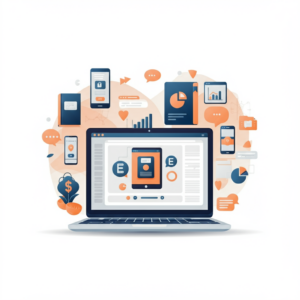
Creating digital products can be a game-changer for entrepreneurs and creators looking to scale their businesses. From eBooks and online courses to software and printables, digital products have low overhead costs and nearly limitless earning potential. But there’s just one catch—not all digital products sell.
To create something successful, you must go beyond just having a great idea. You need to understand what your audience wants, ensure your product delivers value, and market it effectively. Here’s a step-by-step guide to creating digital products that not only sell but also leave your customers coming back for more.
The foundation of any successful digital product is solving a problem that people genuinely care about. If there’s no demand or pain point, it’s going to be tough to generate sales.
Example: Canva, the graphic design platform, identified that non-designers needed a simple tool to create professional-looking visuals. They filled that gap, and now millions use their product daily.
Once you’ve pinpointed your audience’s needs, focus on creating a product that provides tangible value. Remember, your digital product must simplify, educate, or elevate the user’s life in some way. This is where quality trumps quantity.
Example: Marie Forleo’s “B-School” online course doesn’t just offer fluff. It delivers actionable strategies and structured frameworks, making it a go-to for entrepreneurs.
Pricing your product can feel like guesswork, but it’s a critical factor that can make or break your success. Price too high, and you alienate potential buyers. Too low, and you lower its perceived value.
Example: An eBook that offers $100 worth of marketing templates but is sold for $29 is much more appealing when the savings are made clear.
A well-designed product is great, but people won’t buy it unless they understand its value. Sell the outcome, not just the features.
Example: “Notion Templates for Entrepreneurs” by Thomas Frank offers pre-built Notion workspaces AND a detailed walkthrough on how to customize them. This bonus adds immense value.
Even the best products won’t sell if no one knows they exist. Marketing is where many creators struggle, but with the right strategy, you can amplify your reach.
Example: Melissa Griffin created free webinars for her audience, offering valuable tips for starting a blog, and ended with a pitch for her premium blogging course. This strategy earned her millions in sales.
The beauty of digital products is the ability to update and refine them based on user feedback. Over time, you can expand your product’s features, fix issues, or add bonuses that increase its value.
Example: The creators of Teachable, an online course platform, consistently roll out updates and new features, keeping it a favorite among course creators.
Creating digital products that sell isn’t about luck or even just having a great idea. It’s about combining market research, high-quality design, strategic pricing, and effective marketing to craft something people genuinely want and need. By following these steps and remaining dedicated to your audience’s success, you can create products that resonate, sell, and make a lasting impact.
Now it’s your turn. Start small, listen to your audience, and don’t be afraid to improve as you go. Whether it’s an online course, an app, or a digital download, your first product could be the start of something amazing. Good luck!
“Boldly Brandy Marie: Empowering You to Grow, Thrive, and Build Your Financial Freedom.”